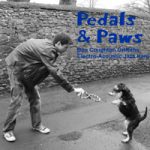Camac Blog
New jazz album from Ben Creighton-Griffiths
Uncategorized
September 16, 2015
Ben Creighton-Griffiths has just released a great new jazz album entirely recorded on our electroacoustic Big Blue. It’s a mix of standards, Ben’s own jazz suite, and three bonus tracks with Mathew Williams on percussion. In contrast to Ben’s previous use of effects and processing, the whole album marks a return to more naked acoustic sounds. “Electronics do feature, but most of the material does not use my effects pedals”, says Ben. “It was important to me and my sound engineer Kristian Evans to be able to capture the acoustic sound of the harp. As harps are always incredibly difficult to record due to the nature of the instrument, the fact that the strings resonate for so long means it can be tricky to achieve the clearer sound that we wanted. However the Blue has a great acoustic sound for this style, it’s very clean and clear which is exactly the tone we wanted.”
Ben is right: any sound engineer will tell you, tears in their eyes, that capturing the acoustic sound of a harp is easier said that done. The instrument’s uncontrolled resonance across a huge range of frequencies causes no end of issues – for more information about this, consult our amplification guide, or Jakez’s blue dictionary. Just as the successful application of makeup enhances one’s natural beauty, so too can the recording of a fine acoustic harp sound be helped by some of the non-acoustic features of the blue harp.
“The Blue harp has been very useful for all of my jazz work, both for concerts and recording”, Ben continues. “The fact that there is a pickup on every string allows me to use the instrument in a very similar way to a guitarist or bass player. This isn’t possible by just placing a microphone near the soundboard or from placing one or two pickups inside the soundboard. Apart from all the effects you can get into, the evenness of the sound from the pickups also makes it very easy to simply amplify the harp in a live situation, or record directly from the harp as a DI (Direct Input). When I recorded the duo tracks for my album with Matthew Williams (in a marathon all-nighter at Cathay’s Community Centre in Cardiff), we were in a smaller room with less kit than when I did the solo tracks. The DI from the blue harp was invaluable, becoming the mics we didn’t have. Also the timbre of the drums and the Blue worked very well, and again the cleanliness and tone of the sound made life a lot easier when working with far less kit. The Blue harp has definitely been an invaluable resource for my jazz work and has allowed me to experiment with ideas that I might not have been able to pursue otherwise. It sounds great in every setting I’ve used it in, from orchestral recitals to jazz gigs.”
 Harpblog has a FREE COPY of Ben’s new album to give away to the first lucky reader who writes in to [email protected] with their postal address. The second, third and fifty-third unlucky readers can still buy the CD from our online boutique, your 24/7 resource for strings, CDs, DVDs, books, sheet music and accessories.
Harpblog has a FREE COPY of Ben’s new album to give away to the first lucky reader who writes in to [email protected] with their postal address. The second, third and fifty-third unlucky readers can still buy the CD from our online boutique, your 24/7 resource for strings, CDs, DVDs, books, sheet music and accessories.
